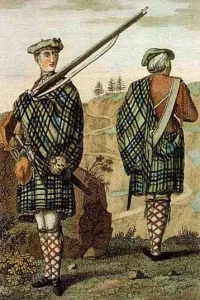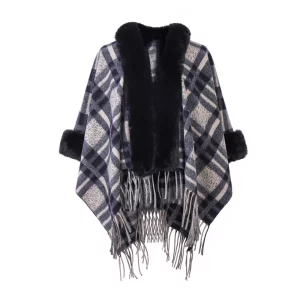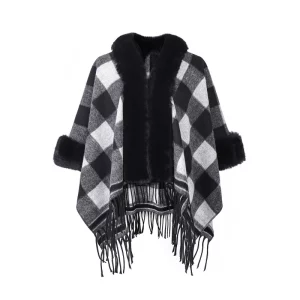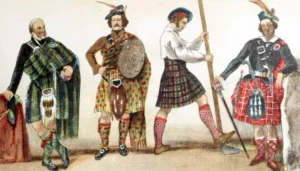Learn about the history of plaid.
Preface:
Hello, plaid lovers!
As the chill sets in, what better way to spice up your outfit than with a warm and stylish scarf? And in the world of scarves, plaid is undoubtedly a timeless classic. It’s sometimes retro, sometimes avant-garde; sometimes preppy, sometimes with a touch of rock ‘n’ roll rebellion.
Have you ever wondered how these interwoven lines have managed to maintain their place in fashion for millennia? Today, let’s embark on a journey through time and space to uncover the mysteries of plaid.
Tell us in the comments what your favorite plaid color combination is!
Tracing Back to the Origins: More Than Just Scottish
When many people think of plaid, images of Scottish bagpipers and the iconic kilt come to mind. While Scotland is undoubtedly a crucial stop in the history of plaid, its origins are far older and more extensive than we might imagine.
The oldest plaid fabrics discovered by archaeologists date back over 3,000 years to Central Europe. The ancient Celts mastered the art of using natural dyes (such as plants and berries) to color wool and weave richly colored plaids. In an era before fashion magazines and trend bloggers, these plaids served not only as aesthetics but also as a way to distinguish different regions, families, and even social status.
The Evolution of Plaid: From Tartan to Plaid
When it comes to plaid, you may have heard another term—Tartan. What’s the difference between the two?
• Tartan: This is the most authentic name for Scottish tartan. It specifically refers to specific patterns closely associated with Scottish clans. Each tartan has a unique, registered design, representing a family’s crest and heritage, a symbol of bloodline and honor. For example, the famous Black Watch tartan originated from a Scottish Highland regiment. After the Battle of Culloden in 1746, the British government, in an effort to suppress Scottish Highland culture, enacted the Dress Act, which prohibited Scots from wearing tartan. However, this has only made Tartan a symbol of resistance and national spirit, gaining widespread popularity.
• Plaid: The word originates from the Gaelic word “plaide,” meaning “blanket.” Originally, it referred to the large, plaid wool blankets worn by Scottish Highlanders to protect themselves from the cold. Later, with the migration of Scottish people to North America, this classic pattern spread with them. American textile mills began mass-producing this plaid, but without the strict clan affiliation of Scottish Tartan. Thus, the word “Plaid” gradually evolved into a general term for various plaid patterns.
Simply put, all Tartan is Plaid, but not all Plaid is Tartan.
Besides the classic Scottish tartan, the tartan family includes many familiar names:
• Gingham: Typically composed of white and one other color, it creates a fresh, pastoral look and is a favorite for spring and summer wear.
• Houndstooth: Named for its resemblance to canine teeth, this checkered pattern is classic and elegant, beloved by fashion icons.
• Buffalo Check: Characterized by large, red and black or white and black squares, it embodies a rugged, retro American workwear vibe.
Which of these checks is a wardrobe essential? Share your thoughts in the comments!
The Plaid Fashion Revolution: From Royal Court to Streetwear
The rise of plaid as a global fashion trend is largely due to Queen Victoria. Her love of Scottish culture saw Tartan grace the royal stage, becoming synonymous with elegance and nobility.
In the 20th century, Plaid’s fashion influence continued to expand:
• In the 1950s, it appeared in the everyday attire of middle-class American families, symbolizing a comfortable and relaxed lifestyle.
• In the 1970s, with the rise of the British punk movement, young people wore torn and pinned plaid as a way to express rebellion and subversion against tradition. Plaid was then imbued with the spirit of rock and roll.
• In the ’90s, from the preppy suits in “Clueless” to Nirvana frontman Kurt Cobain’s flannel plaid shirts, Plaid effortlessly straddled the fashion world’s two extremes: sophistication and decadence.
Today, Plaid transcends regional and cultural boundaries, serving as an inexhaustible source of inspiration for designers. It graces the runways of high fashion and is an essential fashion element in our daily lives.
Your Plaid Story: Embrace Personalization
Every scarf should have its own unique story. The allure of plaid lies not only in its rich history and diverse styles, but also in the endless creative possibilities it offers.
We understand that your aesthetic is unique. Therefore, we offer a personalized scarf service to revitalize the classic plaid.
Here, you can:
• Customize your own plaid logo: Cleverly incorporate your brand logo, initials, or a special commemorative symbol into the classic plaid design to create a unique visual imprint.
• Choose your favorite color: From calming classics to vibrant, trendy hues, we can precisely match your scarf to perfectly complement your skin tone and wardrobe.
• Select the ideal fabric: From warm and soft cashmere to lightweight, skin-friendly cotton and linen to smooth and delicate silk, we offer a wide variety of high-quality fabrics to meet your needs for every season and occasion.
Imagine a custom plaid scarf that carries your personal story, colors, and emotions. It’s more than just an accessory; it’s a statement of your style and taste.
Contact us now to begin your personalized plaid customization journey. Let’s work together to transform this millennium-old classic into something truly unique and special!









